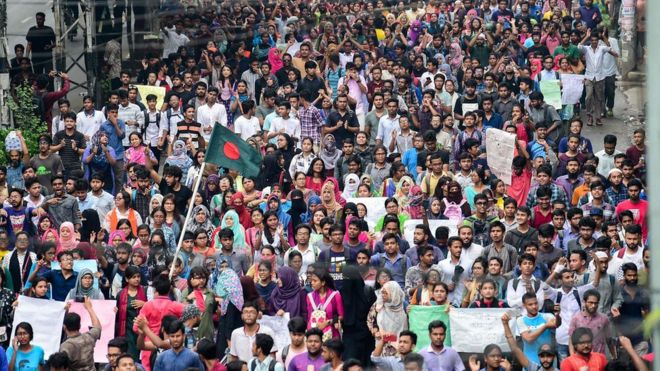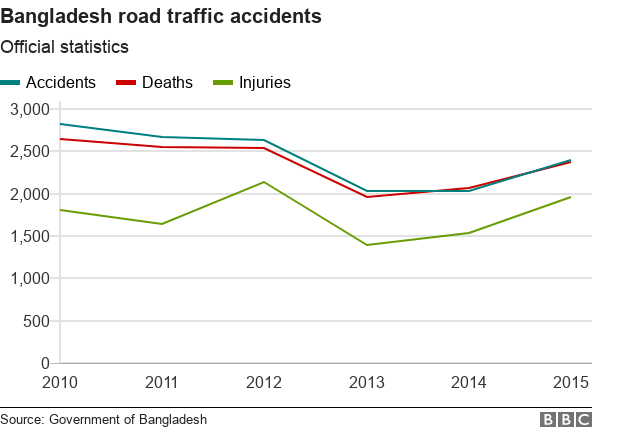
Bangladesh has been gripped by protests since two children were killed by a speeding bus in Dhaka on 29 July.
The news spread quickly via social media and the capital has seen days of sometimes violent mass protests by students calling for action.
Prime Minister Sheikh Hasina has now told them to return to their studies and their demands will be “implemented soon and done systematically”.
So how bad is Bangladesh’s road safety record?
Data collection issues
Bangladesh government data for road deaths and injuries shows much lower figures than those from other sources, including international bodies such as the World Health Organization (WHO).
A major WHO report on road safety in 2015 used modelling to estimate that in 2013 there were between 17,349 and 25,283 road deaths in Bangladesh.
The WHO report says it used a variety of sources including official data, legislative reports and local co-ordinators who used questionnaires and spoke to experts in various fields such as the legal, health, transport and academic sectors.
The official government figure for 2013 was just 3,296.
Why such a big gap?
Safety campaigners in Bangladesh say the government figures are complied using police reports and that many accidents just don’t show up.
And a report last year for the International Journal of Environmental Research and Public Health, which looked at road traffic injuries in rural Bangladesh, referred to “gross under-reporting” by the police.
High-profile road safety campaigner Ilias Kanchan, of the group We Demand Safer Roads, told the BBC: “Not everyone goes to the police station to file a report. And the police don’t always take action when someone does go.”
Mr Kanchan, who lost a his wife in a road accident, says that groups such as his use a combination of official reports, national and local newspaper reports and TV coverage and social media to arrive at their own figures.
Recently, a major newspaper, Prothom Alo, reported a total figure of 25,000 deaths on the roads for the past three and a half years.
One of the country’s leading road accident experts, Dr MB Shamsul Hoque, former director of the Accident Research Institute at Bangladesh University of Engineering and Technology, has carried out research based on talking to individual police stations and toll operators on main routes in Bangladesh.
“You probably have to take the government figures and multiply them by two or three times,” he told Reality Check.
How does Bangladesh compare regionally?
Between 2010 and 2014, there appears to be a decline in fatalities, if you go by Bangladesh government figures, and then the number starts increasing again.

World Bank data indicates deaths per 100,000 people in Bangladesh dropped from 14.1 in 2010 to 12.8 in 2015.
More recent figures are not available.
It’s worth mentioning that neighbouring India as well as Pakistan both have higher fatality rates when you look at the WHO data for 2015.

Globally, Europe is one of the safest places to be on the roads, while parts of Africa, Asia and Latin America are the worst.
According to a report prepared for the UK Parliament this year, Africa had the highest road traffic fatality rate in 2013, at 26.6 deaths per 100,000, while Europe (including Russia, Turkey and Central Asia) had the lowest, at 9.3 per 100,000.
Enforcement and legal issues
Safety advocates such as Ilias Kanchan say they have been trying for years to get successive governments to pay more attention to the issue.
He believes there are number of glaring problems:
- no proper licensing of drivers and corruption in the licensing process
- lack of formal training for those in charge of public vehicles (they often learn on the job)
- poor enforcement by the police and local authorities of traffic regulations
- lack of legal consequences for dangerous driving
Mozammel Huq, of the pressure group Bangladesh Welfare Association, recently told the BBC only about 20% of traffic accident victims took their cases to court as the conviction rate was so low, although there’s no official data to confirm this.
The WHO report on global road safety gave Bangladesh just three out of 10 for enforcement of laws on speed limits.
The government is now saying it is listening.
This week, Roads and Transport Minister Obaidul Kader said that the government had now approved the new transport act and would go to parliament to get approval.
This act will increase the penalties for driving without a licence, driving an unregistered or non-roadworthy vehicle and for modifying a vehicle.
It also introduces a points system for traffic violations and tighten ups some of the conditions for holding a licence.
